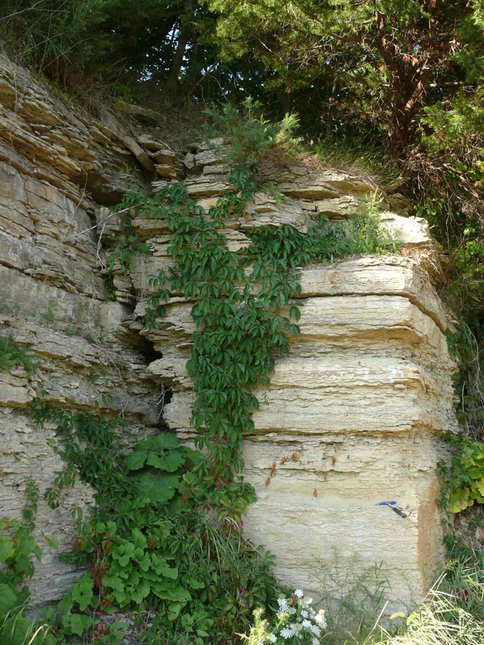2010 Annual Science Report
 University of Wisconsin
Reporting | SEP 2009 – AUG 2010
University of Wisconsin
Reporting | SEP 2009 – AUG 2010
Project 1D: Dolomite Precipitation From Solutions Containing Agar or Carboxymethyl Cellulose, Synthetic Analogs for Extracellular Polymeric Substances (EPS)
Project Summary
A major paradox in the study of ancient sedimentary rocks is that dolomite is ubiquitous in the rock record, and yet is nearly impossible to form dolomite in the laboratory. A common proposal to this dilemma is that microorganisms, especially anaerobic microorganisms, can overcome kinetic barriers to facilitate dolomite precipitation, although their specific role in dolomite formation and nucleation is still unclear. Our experiments demonstrate that disordered dolomite can be synthesized abiotically from solutions containing agar or carboxymethyl cellulose at room temperature. It is now recognized that dehydration / desolvation of hydrated surface Mg(II) is a critical kinetic barrier to dolomite nucleation. Our work shows that dissolving a low dielectric constant solvent in water will lower the dielectric constant of the solution, and thus can reduce the solvation energies of dissolved cations. Tis work therefore provides insight into the mechanisms by which microorganisms may catalyze dolomite formation.
Project Progress
Bio-organics produced by microbes may directly affect mineral crystallization. It has been proposed that microorganisms, especially anaerobic microorganisms, can overcome kinetic barriers to facilitate dolomite precipitation, although their specific role in dolomite formation is still unclear. Microbial cell surfaces and excreted extracellular polymeric substances (EPS), which carry a negative electric charge, may bind to, and accumulate, Ca2+ and Mg2+ ions, and thus are frequently cited as the sites of carbonate nucleation. Herein we provide a new explanation for the dolomite crystallization associated with microorganisms. Our experiments demonstrate that disordered dolomite can be synthesized abiotically from solutions containing agar or carboxymethyl cellulose at room temperature. The dehydration / desolvation of hydrated surafce Mg2+ has been recognized as a critical kinetic barrier to dolomite nucleation. Dissolving a low dielectric constant solvent in water will lower the dielectric constant of the solution, and thus can reduce the solvation energies of dissolved cations. Therefore, we propose that agar and carboxymethyl cellulose, which have low dielectric constants, can lowere the solvation energy of strongly hydrated Mg2+ ions when dissolved in solution, and thereby enhanced their dehydration and incorporation into dolomite nuclei. It is possible that in natural environments, microbial metabolites, exudates or other cellular components, e.g., membranes, EPS may play a similar role as agar does in promoting dolomite nucleation and crystallization. Our new findings may shed new light on the understanding of the role of microorganisms in dolomite formation.
Modern dolomite nano-crystals form in the Deep Spring Lake, California. The sediments is composed of euhedral dolomite nano-crystals and clay minerals.
An outcrop of Ordovician dolomite and partially dolomitized limestone in Prarie du Chien, Wisconsin. Most dolomites are formed through a process dolomitization.
Publications
-
Xu, H., Chen, T., & Konishi, H. (2010). HRTEM investigation of trilling todorokite and nano-phase Mn-oxides in manganese dendrites. American Mineralogist, 95(4), 556–562. doi:10.2138/am.2010.3211
-
Zhang, F., Xu, H., Konishi, H., & Roden, E. E. (2010). A relationship between d104 value and composition in the calcite-disordered dolomite solid-solution series. American Mineralogist, 95(11-12), 1650–1656. doi:10.2138/am.2010.3414
- Huberty, J.M., Konishi, H., Fournelle, J.H., Heck, P.R., H., X. & Valley, J.W. (2010). Silician Magnetite from the Dales Gorge Banded Iron Formation. [Goldschmidt Conference]. Geochimica et Cosmochimica Acta, 73(A): A434.
- Xu, H. (2010). Dolomite, dolomitization and dolomite problem: a new song with old tune. [Goldschmidt Conference]. Geochimica et Cosmochimica Acta, 73(A): A1160.
- Xu, H. (2010). Synergistic roles of microorganisms in mineral precipitates associated with deep sea methane seeps. In: Larry L. Barton, M.M.a.A.L. (Eds.). Geomicrobiology: Molecular and Environmental Perspective. Springer.
- Xu, H., Wang, Y. & Konishi, H. (2010). The role komatiite in governing banded ironformations in the early earth. Fifth International Archean Symposium Abstracts. Geological Survey of Western Australia.
- Zhang, F., Xu, H., Konishi, H., Shelobolina, E.S. & Roden, E.E. (2010). Abiotic synthesis of disordered dolomite in agar gel medium. [Goldschmidt Conference]. Geochimica et Cosmochimica Acta, A: A1203.
-
PROJECT INVESTIGATORS:
-
PROJECT MEMBERS:
Hiromi Konishi
Research Staff
Evgenya Shelobolina
Research Staff
Fangfu Zhang
Graduate Student
-
RELATED OBJECTIVES:
Objective 7.1
Biosignatures to be sought in Solar System materials
Objective 7.2
Biosignatures to be sought in nearby planetary systems



